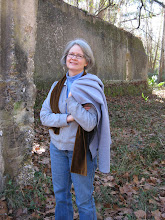Skype: It's like Dick Tracy's watch for me. The future is here.
The 28 students sit quietly and respectfully on the floor of Lab 2, as Amy dials and re-dials the connection. Amy and I had done this a week before and everything worked perfectly, but not now! Alarm! Would we have to cancel? Would our contact get fed up or go off to the next thing on his schedule? (He'd just informed us by email that he'd expected our call an hour earlier, as the U.K. just re-set its clocks this week.)
But wait...we have it! Eureka. Before us on the large projector screen looms the visage of Dr. Michael Lewis, author of The Real World of the Bayeux Tapestry and Deputy Director of Portable Antiquities and Treasure at the British Museum London. MIchael is pleasant and accomodating, patiently waiting for me to repeat every question the students have. And they have many questions.
We learned a great deal from this encounter. Michael knows the scholarship from the centuries and contemporary theories about mysteries associated with the Tapestry. The students remain engaged for 25 minutes, despite the talk running into their lunch hour. One student brought a large picture book of the Tapestry and flips pages so everyone can see the parts under discussion. We have brainstormed questions in advance and the students remember what to ask. They also think of new questions. We are impressed with their interest and Michael tells us later that he is as well.
Afterward, we take a few minutes to debrief. Interestingly, the students are not especially impressed by the feat of technology. This is their everyday world. They have used Skype, they have used it to talk to students and to relatives and friends. They have talked to people in the U.S. and in foreign countries. Alan November was right: if we are not using the available media, we are not [I paraphrase and add my own concept] using all available tools to teach. The students are sophisticated about this tool. And here's the great thing about that: they didn't get distracted by how "cool" it is. When we talked to Michael, they really stayed focused on the task at hand: discussing the Tapestry.
Perhaps, though, to give us credit, we used this tool appropriately. We chose this tool. We chose to Skype instead of to send students roaming around on the internet looking for information, as Amy has pointed out. We tested the tool ahead of time, by emailing Michael, getting his technical person involved, making sure we had speakers, checking the camera angles. We came prepared: we had our list of questions. This was a learning opportunity, not a phone call. Our guest was important; we should not waste his time.
The intangible benefits of this experience are yet to be learned. Natalie believes that whole worlds might have opened for some students who saw a person who has made his life's work studying something they are studying at 10 years old. Michael's passion was infectious. He also told great stories, memorable for the students. I wonder if now they will ask whether we could Skype with authors or other scholars on other subjects. Should we be looking for other chances to use this same technology or for ways to extend what we learned from this particular session with Michael (more on the Bayeux Tapestry?)?
One thing we will do is to write Michael by snailmail. We want to show the students that there are many ways to communicate and that formal offers of thanks are important. We can send Michael our drawings by snailmail. We can write personal notes with handwriting and coloring that he can post in his office if he wishes. We can send him grits and a class photo.
What a day. William the Conqueror would be astonished. And would wish he'd thought of it.
Wednesday, April 1, 2009
Subscribe to:
Posts (Atom)

